MARIANI’S
Virtual
Gourmet
May 21, 2023
NEWSLETTER
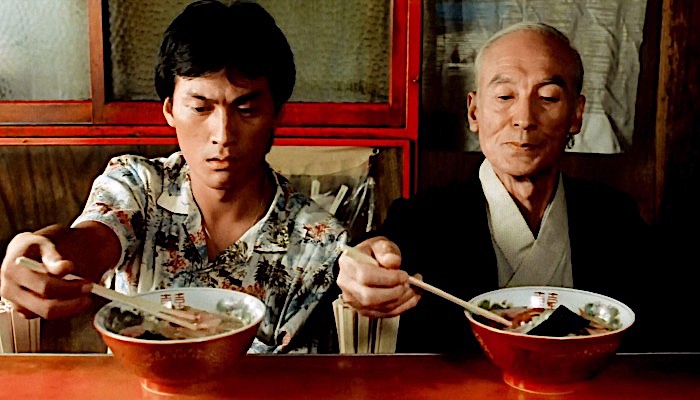
Ken Osawa and Hiedji Otaki in "Tampopo" (1985)
❖❖❖
THIS WEEK
ITALY FOR FOOD LOVERS
By John Mariani
NEW YORK CORNER
GENESIS HOUSE
By John Mariani
GOING AFTER HARRY LIME
CHAPTER TWENTY-ONE
By John Mariani
NOTES FROM THE WINE CELLAR
CHILE'S VIÑEDO CHADWICK VIES
WITH BORDEAUX AND NAPA
By John Mariani

By John Mariani
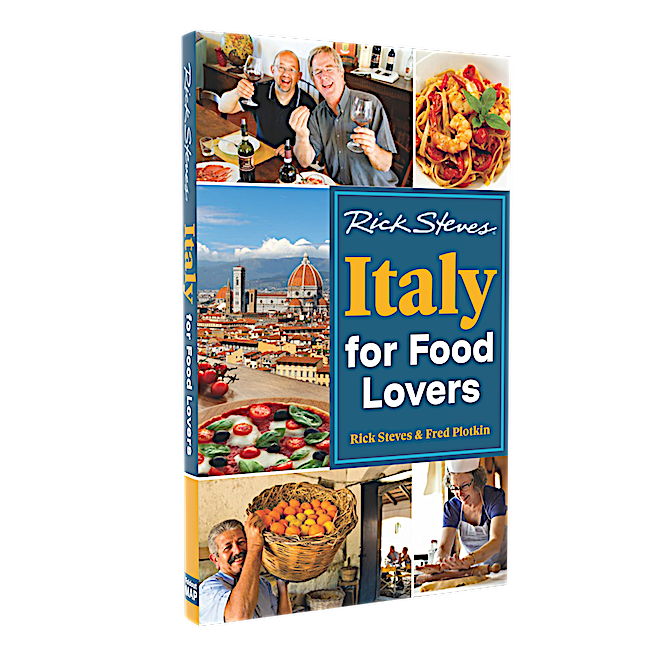
Through his TV shows and books Rick
Steves is, to
my mind, by far the most
useful of guides to Europe, as affable
as Ted Lasso and more knowledgeable than
scripted TV actors like Stanley Tucci, Eva
Longoria
and Anthony Bourdain. Fred Plotkin has
proven himself the most authoritative
food guide to Italy (as well as a highly
regarded opera scholar), so the two
getting together for a just-published book,
Italy
for Rick Steves Food Lovers ($22),
which combines his travel expertise
with Plotkin’s exhaustive familiarity
with Italian food culture. The book explains
everything, from why Italian food
is different from any other in Europe; how
to pick a restaurant in any region
of Italy; manners and customs; tipping and
not tipping; and recommendations for
their favorite restaurants.
I interviewed Fred Plotkin about how
the
two collaborated.
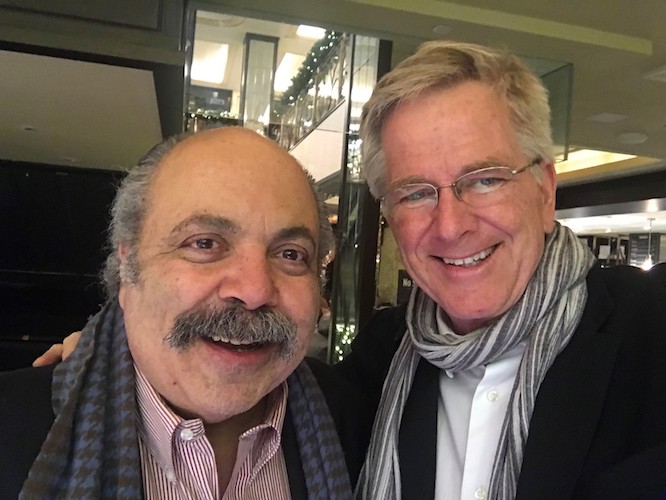 How did you and Rick
Steves collaborate on this book?
How did you and Rick
Steves collaborate on this book?
Rick had the idea and
approached me in the Spring of 2021. He had
done 49 books, with his bestseller
being his guidebook to Italy, and decided, for
his 50th, that he would return
to an Italian theme. He had never done a food
book before, and Italian food
seemed a natural. I’d appeared on many of his
radio shows going back at least a
decade. Audiences always seemed to respond to
my appearances, and he and I had
an easy rapport. Interestingly, we had never
met in person and had never
traveled together. A few years ago he was in
NYC on a quick trip, we had a
30-minute coffee on West 58th Street and did a
selfie that I think is in the
book. With no one traveling in 2021, with Rick
in Seattle and me in NYC, we did
this book by writing our own parts and
exchanging documents electronically,
then reading each other’s work, sorting out
details, finding a voice and
agreeing when to disagree and saying that “one
of this book’s authors believes.
. .” You will see that the voice of
the book is mostly “I” and it is us unless we want to emphasize the
experience and outlook of just one
of us.
But it was not intended to be a
strict restaurant guide?
We both agreed from
the
start that this is not a restaurant guide,
because they date quickly. We wanted
to create a book that would give the traveler
tools to not only to find a good
place to eat in Rome, Florence or Venice but
to be able to go anywhere in Italy
(as is my wont) and find what is local,
traditional and genuine. That is why we
cover all 20 regions 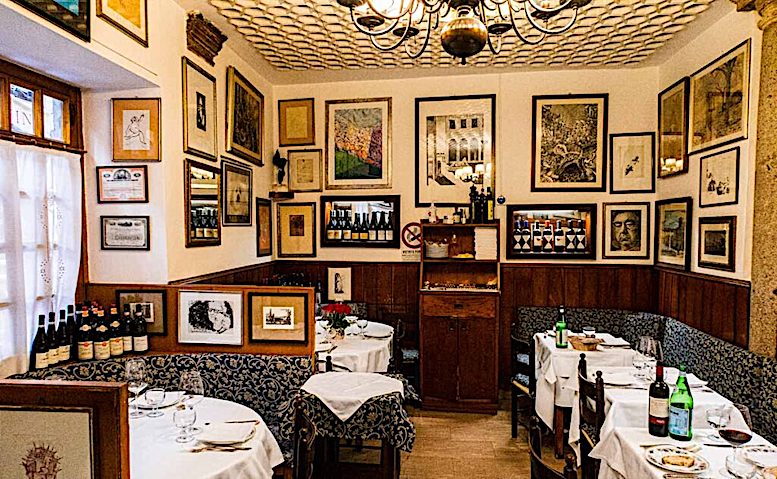 and
have a very long glossary that contains foods
that the
traveler would encounter whether he is in
Novara, Macerata or Alghero, or
hundreds of other towns. Rick and I do each list 50
restaurants we like. His are more on
the beaten path, mine less so. These are not
Italy’s 100 “best “restaurants (I
don’t believe in such a thing) but 100
restaurants of different levels that we
would be glad to dine at. So, no, it was not
about length that had us limit
restaurants. It is more that the book’s
intention was to have the traveler
explore and discover things with my expertise
on Italian food culture being
their guide.
and
have a very long glossary that contains foods
that the
traveler would encounter whether he is in
Novara, Macerata or Alghero, or
hundreds of other towns. Rick and I do each list 50
restaurants we like. His are more on
the beaten path, mine less so. These are not
Italy’s 100 “best “restaurants (I
don’t believe in such a thing) but 100
restaurants of different levels that we
would be glad to dine at. So, no, it was not
about length that had us limit
restaurants. It is more that the book’s
intention was to have the traveler
explore and discover things with my expertise
on Italian food culture being
their guide.
Your own Italy for the Gourmet
Traveler
has been the best guide to food and
restaurants in Italy. Are you going to do
another edition?
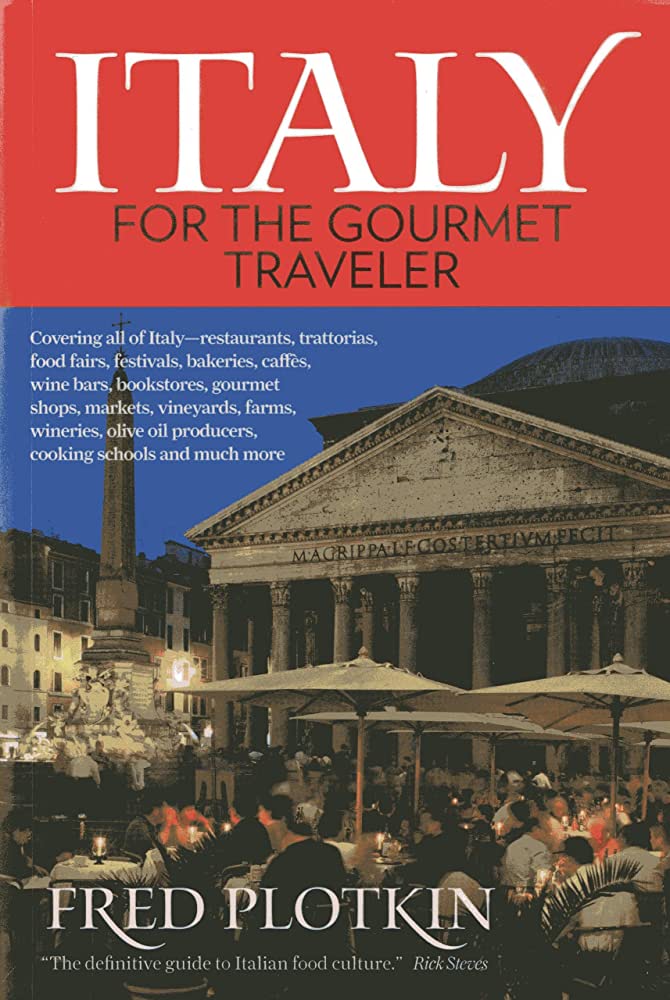 It’s gone through
six
editions that I assiduously updated between
1998 and 2014, and I’d planned to
do a seventh, but my British publisher
retired. When Rick approached me, it was
during the pandemic and I was not traveling
anywhere, so I decided to take the
core knowledge of my previous books but not
all the listings of restaurants,
shops, bars, gelaterie,
bakeries,
cooking schools and more. Obviously, I
researched as if for the first time what
I intended to put in print. If the text from Gourmet
Traveler worked, I
used it. Otherwise, I created something new
that spoke to what I know and believe now.
It’s gone through
six
editions that I assiduously updated between
1998 and 2014, and I’d planned to
do a seventh, but my British publisher
retired. When Rick approached me, it was
during the pandemic and I was not traveling
anywhere, so I decided to take the
core knowledge of my previous books but not
all the listings of restaurants,
shops, bars, gelaterie,
bakeries,
cooking schools and more. Obviously, I
researched as if for the first time what
I intended to put in print. If the text from Gourmet
Traveler worked, I
used it. Otherwise, I created something new
that spoke to what I know and believe now.
How did you split up the work?
Everything in the
Italian
language was my responsibility and, in reading
the book since, I have only
found two typos in Italian—one a name missing
a letter and the other a slight
misspelling. These will be fixed when we
reprint.
What is the problem with
Michelin Guides’ Italian guidebook?
Italians want you at
the
table savoring the food, which represents the
culture and tradition rather than
mere innovation, although they always have
innovated, as with the tomato that
comes from America. Italy historically has
extraordinary ingredients, whereas
the French did not have such excellent crops
and had to cover them up with
sauces.
Why is Italian food so great?
Italian food
is greet because it’s served with love.
Around the table you don’t age. A conviviality
and family tradition, family
recipes and you go to their homes and pull out
old books from 1897 how to make
a sauce, and they make these recipes that
represent their own traditions.
How do you pick a restaurant?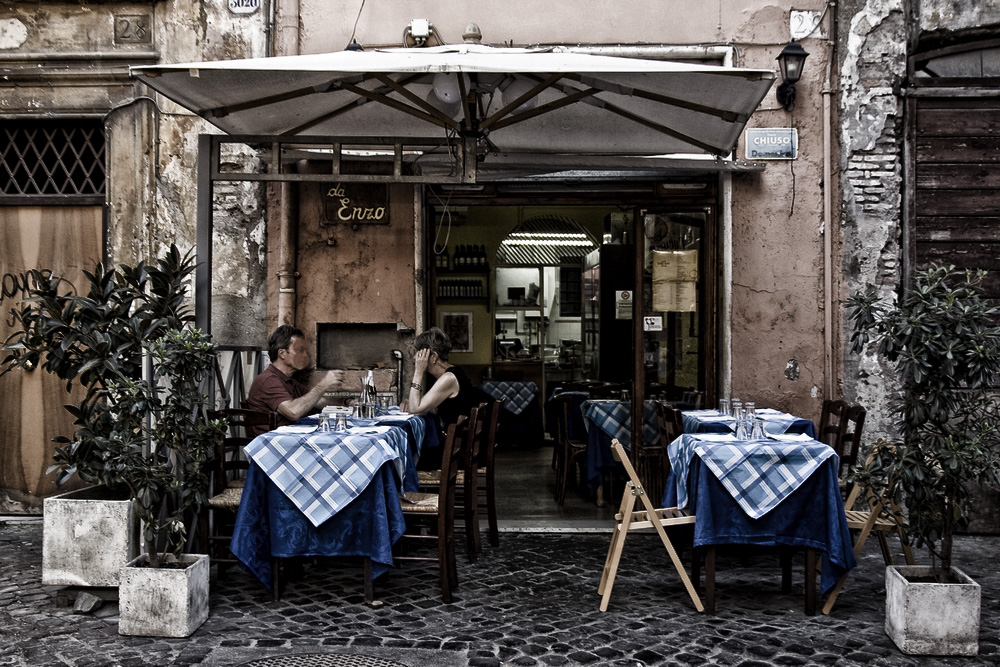
I am led by my nose,
I
smell something rather magnificent and I ask “Signora, what are you making?”
and that leads to a conversation. My
books reflect home cooking because I went to
school in Italy and had friends’
family dinners. I didn’t learn from cooking
school but basically the way the
Italian homes teach. If you see very
long menus in many languages, avoid that. You
want a restaurant? Ask what's
good that day—5 or 6 items.
The bill. Do we have to tip?
 There’s
the coperto,
a very old term, when you go to
a trattoria and you are paying the cover
charge for bread and tablecloth—pane e
coperto—2 or 3 euros. Beyond that
you do not have to tip at all. However, round
up, not by much, maybe if your
bill is 47 euros pay 50 as an acknowledgement
of you’re being pleased.
There’s
the coperto,
a very old term, when you go to
a trattoria and you are paying the cover
charge for bread and tablecloth—pane e
coperto—2 or 3 euros. Beyond that
you do not have to tip at all. However, round
up, not by much, maybe if your
bill is 47 euros pay 50 as an acknowledgement
of you’re being pleased.
Do they take credit
cards
all over Italy?
More so than before,
but
some do not take Amex but take the other cards
like Mastercard and Visa. Always
good to check ahead.
Traveling with children is a
chore, except in Italy.
They and old folks are
guests of honor and treated with great love
and respect, for some reason
Italian children don’t shout. The volume in
restaurants is much softer
than
in American restaurants. I don’t want my
ears assaulted. 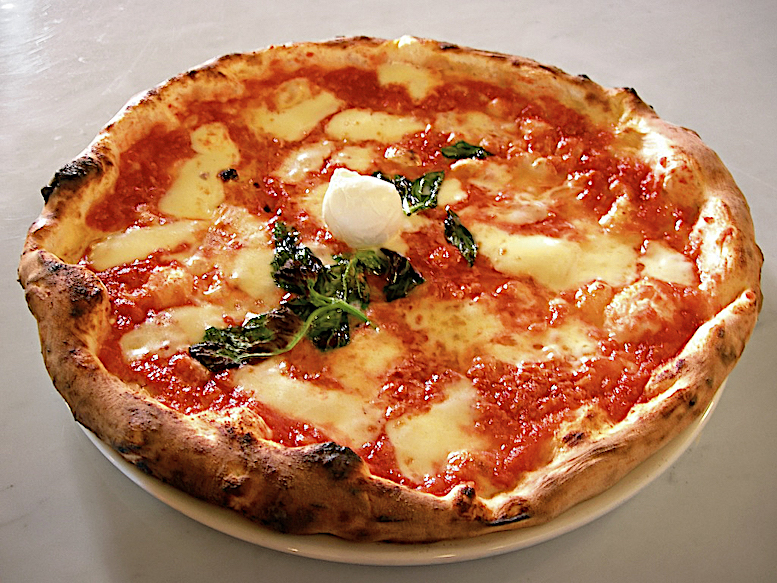
What
should we know about pizza?
In Italy it’s not laden
with a ton of ingredients or thick crust,
like Chicago-style, which could give you a
coronary. Portions here are enough
for three persons. In Italy you get a
smaller, more digestible portion. Pizza
has mozzarella, olive oil, tomato and basil.
In Naples they might have friarelle
bitter greens that come out only in the
winter. A little bit of fish.
Elsewhere they add local prosciutto, Speck
in the Alps. The Neapolitan
pizza is still the gold standard.
NEW YORK CORNER
GENESIS
HOUSE
40A 10th Avenue
855-444-0836
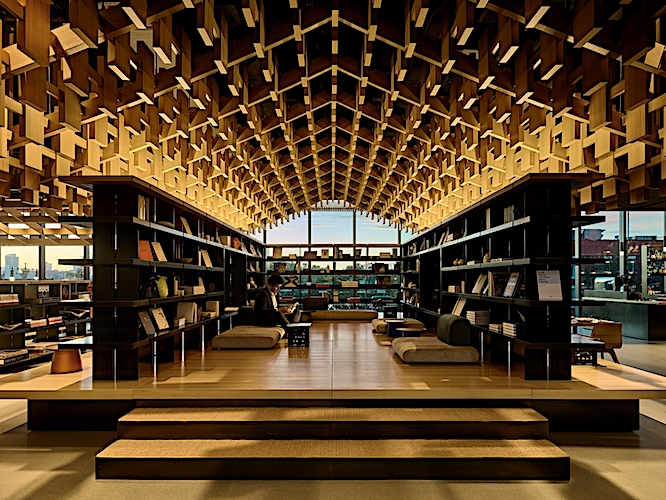
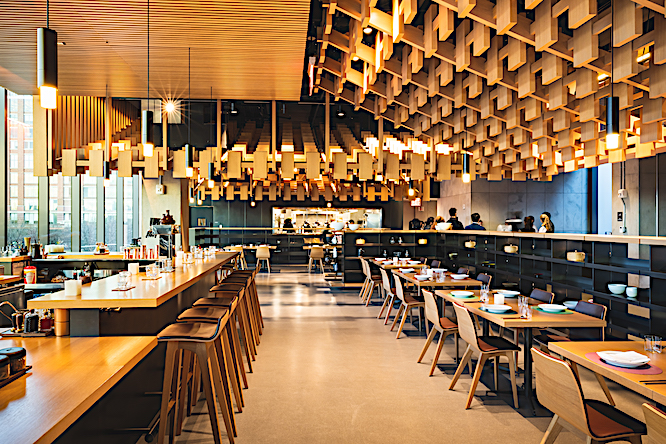 There
is
a sleek bar area, a section with counter
seating, a tea pavilion and an airy
library section up three steps, its shelves
filled with art, fashion and travel
books. It’s all quite serene and the tables are
widely separated, set with
exquisitely thin Glasvin stemware. There is
music, a little too intrusive, but
the separation of sections keeps the noise down.
There
is
a sleek bar area, a section with counter
seating, a tea pavilion and an airy
library section up three steps, its shelves
filled with art, fashion and travel
books. It’s all quite serene and the tables are
widely separated, set with
exquisitely thin Glasvin stemware. There is
music, a little too intrusive, but
the separation of sections keeps the noise down.
The restaurant
is the first international expansion
for Onjium Studios, a
Seoul-based cultural institute led by
artisans Cho Eun-hee and Park
Sungbae, dedicated to creating a “new heritage”
based on traditional Korean
clothing, food, and housing. The contention is
that the restaurant’s cuisine
derives from ancient bang-ga recipes of the royal
Joseon Dynasty, which dates to the
14th century (abolished in the late 1800s).
It
is, then, a tad difficult to know how the kind
of food Executive Chef Losa
Salvieus Yi creates is true to form. No matter:
it is true to a sensibility of bang-ga
harmony and refined presentation,
right down to the diverse ceramics used. The
metal chopsticks are lovely to
look at, but offer too 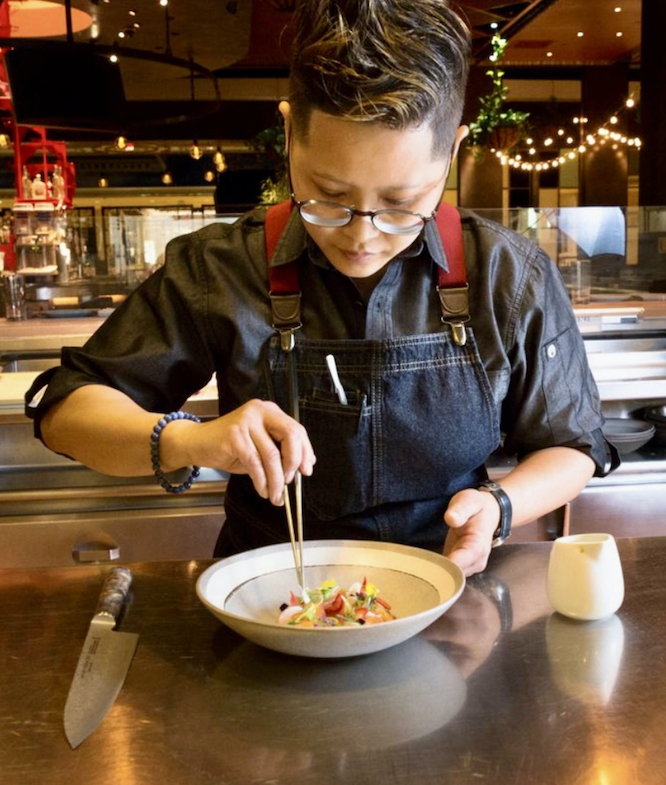 slippery
a surface with which to pick up the food. The
stemware, by the way, is elegantly light and
thin by Glasvin.
slippery
a surface with which to pick up the food. The
stemware, by the way, is elegantly light and
thin by Glasvin.
Yi
was born in Korea, moved to New York City to
study at the Culinary Institute of
America at Hyde Park, then trained at Gotham Bar
& Grill, Daniel and
Aquavit before relocating to London to work at
The Savoy. Next stop Vegas, at
Joël Robuchon at the MGM Grand. Following the
pandemic, Yi returned to Korea to
immerse herself in the local culture and cuisine
of Seoul.
You
may dine à la carte or with a five-course
tasting menu at $175, with a $115
wine pairing. The à la carte items are quite
expensive and portions not large,
so the tasting menu is the better option.
Burgundy-born General Manager Kevin
Prouve has put together a canny
wine list that goes well with Yi’s cooking,
which involves unusual seasonings
and ingredients rarely seen this side of the
Pacific Rim.
All
dishes are amply described on the menu,
beginning with some Korean snack foods
($14 each): Gim bugak,
a fried
seaweed chip, along with a delightful
pop-in-the-mouth treat called gotcam cheese mari, made
of dried
persimmon, Brie Fermier cheese, Brillat
Savarin and walnuts.
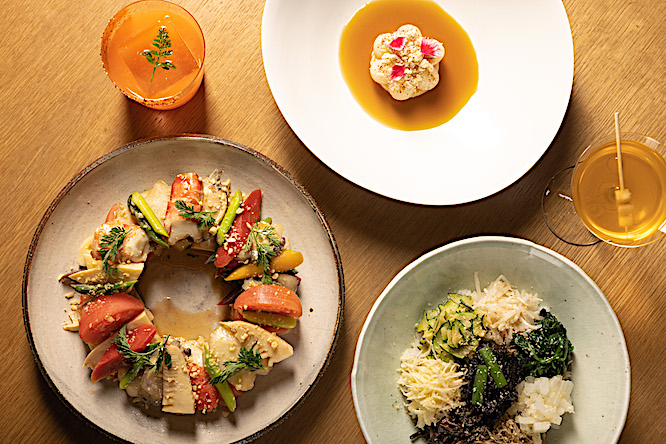 A
fanfare of small plates begins with suranchae
($39) of chilled abalone, scallop, snow
crab, octopus, poached egg and
crispy pear with a pine nut sauce, based on a
dish from a clan in Gyeongju.
Abalone makes another appearance in daeha
yukjeup naengchae ($37),
along with
prawn, Asian pearl mushrooms, asparagus and a
deliciously tangy but
not-too-pungent mustard meat sauce. Jinju
bibimbap ($35) is subtly flavored moo radish,
spinach, bracken fern, mung
bean sprouts with a steamed dumpling sauce.
A
fanfare of small plates begins with suranchae
($39) of chilled abalone, scallop, snow
crab, octopus, poached egg and
crispy pear with a pine nut sauce, based on a
dish from a clan in Gyeongju.
Abalone makes another appearance in daeha
yukjeup naengchae ($37),
along with
prawn, Asian pearl mushrooms, asparagus and a
deliciously tangy but
not-too-pungent mustard meat sauce. Jinju
bibimbap ($35) is subtly flavored moo radish,
spinach, bracken fern, mung
bean sprouts with a steamed dumpling sauce.
Large
plates are largely seafood and vegetables, as
with tongyeong domijjim ($40), a dish
from the
port city of Tongyeong made of fleshy sea
bream, gochujang
red chile paste,
shiitake mushrooms  and
zucchini; goldong
myeon ($29) is a mix of nutty wheat
noodles rife with shiitakes, onion,
zucchini and a soft-cooked egg that brings it
all together with a velvety
texture.
and
zucchini; goldong
myeon ($29) is a mix of nutty wheat
noodles rife with shiitakes, onion,
zucchini and a soft-cooked egg that brings it
all together with a velvety
texture.
Desserts
are not as rich or sweet as Western desserts—and
very pricey à la carte—but
they have their own pleasures, as in baesuk,
made with ripe poached pear, pink peppercorn
crumble and cream ($19),
and pat sirupyeon, which is a steamed
rice cake with vanilla red bean
crunch ($17).
You’ll end off with “tea
snacks” like a yakgwa,
a honey and
sesame cookie ($11).
Genesis
House’s cuisine obviously deserves the
term exotic, but in more subtle ways
than more familiar Korean food in New York,
which is often based on slices of
beef cooked on a fiery brazier set in the center
of the table. There are no
pyrotechnics at Genesis House, but there is a
great deal of individuality and
style throughout a meal whose setting is itself
quite luminous.
Open for dinner
Tues.-Sun.
GOING AFTER HARRY LIME
By John Mariani

CHAPTER TWENTY-ONE
“Doesn’t sound good, does it?”
Katie
said to David on their way out the front
door.
“Let’s just wait and see. You never
know. Maybe
after all these years Philby
wants to set the record straight.”
They took the Moscow Metro back to
their hotel just to try to familiarize
themselves with the system, then met in
Katie’s room to wait for Rufina Philby’s
call.
As it got closer to six o’clock Katie
was becoming more anxious, while
David seemed more resolved that they
wouldn’t be hearing from Madame Philby. He
sat on the sofa reading the International
Herald
Tribune.
The Yankees took the
American League pennant, the Braves took the
National.
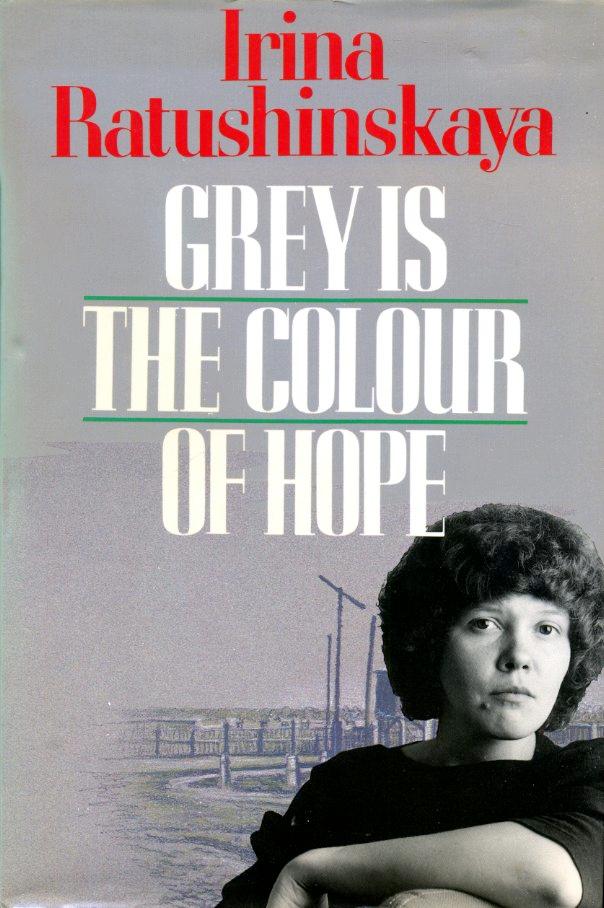 It was ten after six
when there was
a knock at the door. David answered. A hotel
porter handed him a thin package
for Katie Cavuto.
It was ten after six
when there was
a knock at the door. David answered. A hotel
porter handed him a thin package
for Katie Cavuto.
“It’s for you,” said David. “Looks
like a book or something.”
They tore off the plain wrapping to
find it was a book of poems by a
contemporary Russian poet named Irina
Ratushinskaya. There was a slip of paper
between two pages with a note reading
“Eleven AM tomorrow.”
The poem on the page, “I Will Live
and Survive,” had several lines highlighted
in yellow marker. They read:
I
will live and survive and be asked:
'Doesn't
it hurt you to remember?'
Not
being
deceived by my outward flippancy.
But
the
former names will detonate my memory
–
Magnificent
as
old cannon.
And I will tell of the
best people in all the
earth,
The most tender, but
also the most
invincible,
How they said
farewell, how they went to be
tortured,
How they waited for
letters from their loved
ones.
And
I'll
be asked: what helped us to live
When
there
were neither letters nor any news - only
walls,
And
the
cold of the cell, and the blather of official
lies,
And
the
sickening promises made in exchange for
betrayal.
David said, “Looks
like Kim Philby’s
showing no remorse.” “English?”
asked
Katie. She
then noticed a middle-aged woman
with her hair half blond, the other half
black, wearing what appeared to be
folkloric Georgian dress, with plenty of
silver bracelets and bangles. She
would talk at a high tone of voice to one
table, then, without waiting for a response,
move to the next one over and
begin again.
All her guests seemed to be
on familiar terms with her.
“Pretty amazing,” said Katie,
“Pretty damn amazing. Well, let’s try to
find some dinner and get a good
night’s sleep. Oh, I was talking to the chef
at the restaurant downstairs. He’s
Finnish, but he told me there is one good
restaurant we should  check
out.
Called Guria. He said it’s run by a
crazy old lady named Madame Zoya, the
food is Georgian, and he said it’s
always been a journalists’ hang-out.”
check
out.
Called Guria. He said it’s run by a
crazy old lady named Madame Zoya, the
food is Georgian, and he said it’s
always been a journalists’ hang-out.”
David said, “That means it’s also a
hang-out for Russian spies. That could prove
either interesting or contrary to
our plans. Well, if the food’s any good,
it’s worth a shot.”
They took the Metro again, out to
Park Kulturi, and with little difficulty
found the restaurant on Komsomolsky Prospekt in Gorky Park.
The interior was very odd, with inlaid stone
and wooden walls, paintings
attached to angled ceilings, ornate wooden
chairs, a grandfather clock, deer
antlers and in one side room a stuffed
Russian bear.
As usual in Moscow restaurants, the
greeting
was perfunctory, customers sat wherever they
could find a spot, and it took ten
minutes before a waiter came by, slapping
down a handwritten menu in Russian.

“Nyet,”
said
the waiter, who walked away.
Katie was smiling at the ineptitude
of it all; David was not.
“Well, at
least they have a wine
list,” Katie remarked. “Pretty cheap, too.
Think we should ask the waiter for a
recommendation?”
“I don’t think that’s a great idea,”
said David. “Let’s just take our chances.”
Another ten minutes passed before
the waiter came 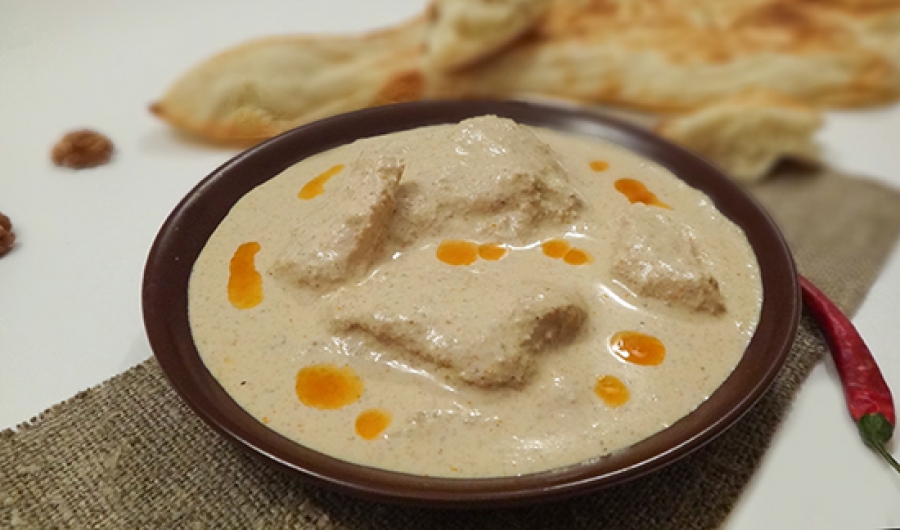 back and the two
Americans ordered. “The
chef at the hotel said the garlic and
walnut chicken satsivi
(right) and the lamb
on skewers are pretty
good,” said
Katie.
back and the two
Americans ordered. “The
chef at the hotel said the garlic and
walnut chicken satsivi
(right) and the lamb
on skewers are pretty
good,” said
Katie.
“You don’t mind if we skip the zakuski,
do you?” asked David, nodding
at a table of tired looking appetizers.
“They look awful.” He went with the
lamb on a skewer.
The wine came—from Georgia—and was
opened and sloshed into the glasses without
asking if Katie or David wanted to
taste it first.
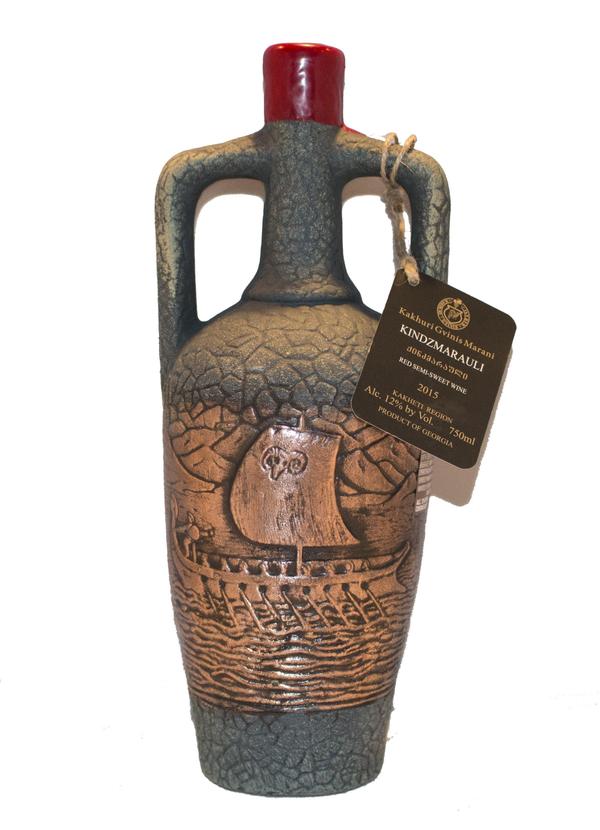 “Ever hear what
Hemingway called a
wine he once had?” asked David. “He said it
was ‘a very Corsican wine and you
could dilute it by half with water and still
receive its message.’”
“Ever hear what
Hemingway called a
wine he once had?” asked David. “He said it
was ‘a very Corsican wine and you
could dilute it by half with water and still
receive its message.’”
Katie laughed and said, “Well, then
let’s toast to Papa Hemingway  and try to get this
stuff down.”
and try to get this
stuff down.”
“So we’re in Gorky Park,” said
Katie.
“So?”
“ You never read Gorky
Park? It’s a crime novel by Martin
Cruz Smith, though he said he never set foot
in Moscow. It came out about
twenty years ago, about an arrogant Russian
cop investigating three murders
here in the Park. I forget why, but it
involves Russian sables.”
“Fur coats?”
“No, live ones, to make into fur
coats.
Good book.”
As they
looked around the dining
room, Katie and David saw it was filled
mostly by men dining alone, mostly
raucous Russians, with a few others they
heard speaking English or French.
Katie picked up on one with a British accent
who made reference to the
London-based Guardian
newspaper. David
said, “I suppose you’d like to chat with
that guy to see if he knows anything?”
“Back in New York, maybe. Here,
uh-uh. We’ll play this close to the vest,
though I’d sure like to know if they
could be any help.”
“Stifle it, Katie. This place could
be
crawling with spies.”
“I keep forgetting the Cold War
isn’t entirely over.”
“I’m guessing that’s Madame Zoya,”
said Katie. “Effectively ethnic looking.”
“Looks a little like a younger Mrs.
Khrushchev,” said David. “Hope she doesn’t
come
over here.”
But, of course, Madame Zoya did,
booming, “You Americans, yes? Welcome to the
best restaurant in Russia! I
am the owner and everyone who comes here is
my friend!
Where you from?”
Katie said New York and Madame Zoya
whooped,
“Ah! New York, New York.” She
then started to sing—without knowing the
words—the melody to the city’s
anthem.
“Da-da-dada-da, da da dada
da! I
want to visit New York before I die.
Maybe I go live there, open a real
Georgian restaurant. You
know people who could help me?”
Katie and David were pretty sure
they were not the first Americans Madame
Zoya asked this question, but the
woman didn’t follow up, saying, “Well, you
eat and drink. We talk later. Buy
you a vodka.
How you say it? Over the house?”
“On
the house,” said David.
Madame Zoya snapped her fingers at a
waiter and said, “Prinesite
im dve vodki!”
then swept away from their table to another.
Two glasses of chilled vodka of
questionable provenance arrived.
“Well, down the hatch,” David said.
Katie’s eyebrows shot up and David shook his
head.
“Whew! I see she gave us her best
stock,” said David.
The food came, along with some
steaming hot Georgian bread.
“How’s the chicken?” asked David.
“Better than a lot of what we’ve
been eating.
Bread’s delicious. How’s
the lamb?”
“As lamb goes—assuming this is lamb—it’s
a little chewy but okay.
Kind of an antidote for the wine and vice
versa.”
© John Mariani, 2016
❖❖❖
CHILE'S VIÑEDO CHADWICK WANTS
TO VIE WITH BORDEAUX
By John Mariani

Winter in the Maipo Valley, Chile
In 1980 Chilean
wine production totaled
barely 900,000 liters. In 2022, Chilean wine
production totaled 1.244 billion
liters, a 7.39 percent decrease from 2021.
Likewise, in 2022, Chilean wine
export volume totaled 833.5 million liters, a
4.0 percent decrease from 2021. Long dominated by Concha y Toro
(founded in 1883), Chile's wine industry began
to make fine wines for export
only in the 1990s, after post-war decades of
heavy taxation and lowered wine
consumption. But, after changes in government
policy made viticulture
profitable, old and new wineries began ripping
out weak varietals in favor of
premium grapes like Cabernet Sauvignon,
Carménère, Merlot, Chardonnay and
Sauvignon Blanc.
Established wine producers from Europe
and the U.S. took notice and invested heavily in
Chile, including Spain's
Miguel Torres and France's Lafite-Rothschild,
Mouton-Rothschild, Cos
d'Éstournel, G.H. Mumm, and Grand Marnier. In the
mid-1990s California wine
magnate Robert Mondavi invested $12 million in
Chile's Viña Errazuriz vineyards
to start up his own Caliterra brand.
There's even a joke among California
winemakers that the best place to
meet their neighbors is in the lobby of the Hyatt
Hotel in Santiago.
This soaring growth in both volume and
consistent quality has led some Chileans to aim
for the same firmament and
prices claimed by Bordeaux and Napa Valley. One of
the leaders is Viñedo Chadwick, whose top Cabernets are
selling
for $350 a bottle. I interviewed Juan Carlos
Pagola (below), managing director of
Viñedo Chadwick, as to how such success has been
achieved.

How did Chadwick get such an
English-sounding name?
The
ancient Chadwick surname
originated in Scandinavia during the Viking
period. From there, it re-emerged
in France and later flourished in England and
Scotland before crossing the
Atlantic to North and South America. Don Alfonso
Chadwick was part of the third
generation of the Chadwick family in Chile,
descendant from Thomas Chadwick,
who was a British mining engineer who headed to
the new continent looking for
opportunities and settled in the North of Chile in
1820. Don
Alfonso was an accomplished polo player
and a visionary in the modernization of the
Chilean wine industry, and also
considered the father of Puente Alto D.O. Viñedo
Chadwick holds his name as it
represents the family’s long-cherished desire to
honor his memory. This unique
wine showcases the family’s heritage and tradition
of producing fine wines,
with passion for excellence.
Chadwick
began plantings in 1992 but
took 7 years to produce its first vintage. Were
you buying others’ grapes in
the meantime? Why did it take 7 years?
Aware
of the potential of the
Puente Alto terroir, Eduardo Chadwick convinced
his father, after his
retirement from polo, to transform his beloved
polo field into a world-class
vineyard, planting Cabernet Sauvignon vines in
1992. The first vintage released
of Viñedo Chadwick was 1999. During those seven
years in between, Eduardo (below) and
the team worked tirelessly to nurture and train
the vines to produce the best
possible wine, as it takes time and perseverance
to handcraft a truly fine
wine. With the great quality of this first 1999
vintage, it was clear that
Viñedo Chadwick was off to a flying start.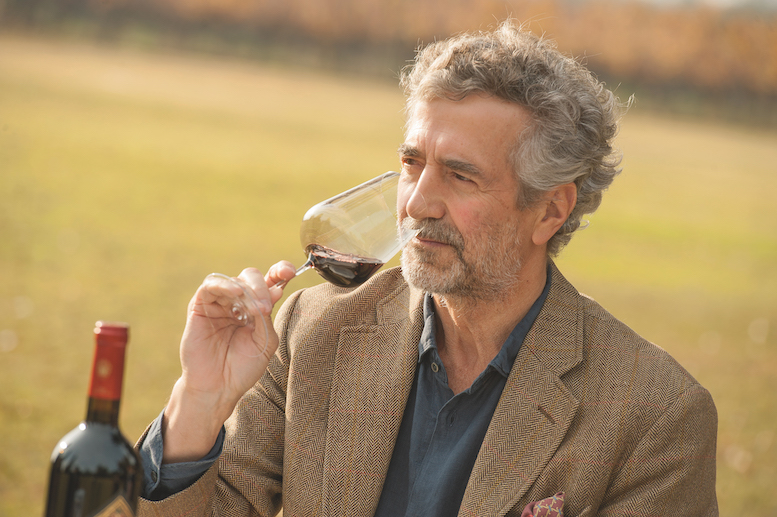
What was the Berlin
Tasting and what was the
result in the world press?
On
January 23, 2004, inspired
by the Judgment of Paris, Eduardo Chadwick and
Steven Spurrier invited Europe’s
most highly regarded wine experts to take part in
a historic blind tasting in
Berlin. The challenge was to show that Viñedo
Chadwick and other fine Chilean
wines were at a similar level of quality as the
most prestigious wines of the
world. The result of this historic tasting proved
to be a true eye-opener:
Viñedo Chadwick 2000 was placed first, above the
First Growth wines from
Bordeaux of the millennium vintage, most of which
had been awarded 100 points
by Robert Parker, as well as the Super Tuscans
from Italy. This revolutionary
event for the global wine industry, known as “The
Berlin Tasting”, turned out
to be a milestone for the appreciation of the
superb quality of Viñedo Chadwick
and led to the discovery and recognition of Puente
Alto D.O. Maipo Valley as a
world-class appellation.
The
number of wineries in Chile
rose from 12 in 1995 to over 70 in 2005. What
caused this enormous growth?
Actually,
vines arrived in
South America in the 1600s with the Spanish
Missions, so wine has been part of
the Chilean culture for longer. Later in the 1900s
some traditional Chilean
wineries were established with a more modern
approach of winemaking, but it was
still for local consumption. And since 1983 Chile
opened to exports and that
also boosted the growth and modernization of
established wineries, as there
appeared more business opportunities in addition
to the country’s economic growth
and investment from abroad that started in the
1990s.
Chile was never
affected by phylloxera. Do you
have any pre-phylloxera vines in the estate?
In
1992, the fifteen-hectare
Viñedo Chadwick vineyard was carefully planted
with Cabernet Sauvignon vines
from a massal selection. These were entirely
ungrafted, as is still common in
phylloxera-free Chile, and had been selected on
the basis of their age and
quality from another estate of the family. New
plantings were done in 2015 with
Cabernet Sauvignon French clones planted on
rootstocks, to add yet more
complexity to the blend.
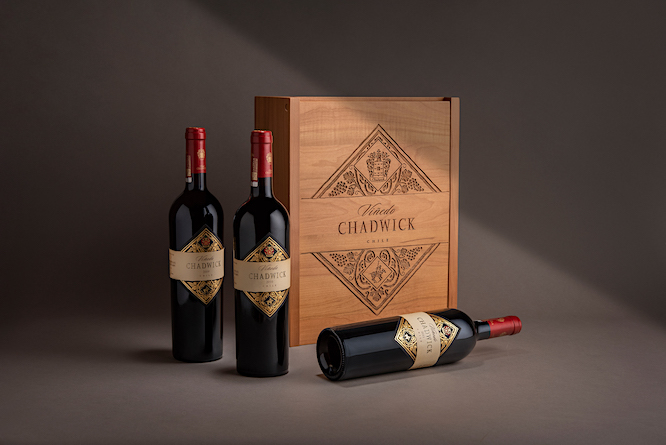 Given
that Chile’s Maipo has more consistent
weather than Bordeaux, do vintages differ very
much at Chadwick?
Given
that Chile’s Maipo has more consistent
weather than Bordeaux, do vintages differ very
much at Chadwick?
Vintages
do differ at Viñedo
Chadwick and we obtain wines that express the
terroir in those different
conditions. What we have in Puente Alto that is
much beneficial for the vines
is that rains are concentrated in winter and
summers are usually long and dry
so we are able to consistently mature the grapes
in very healthy conditions
until picking time.
Has
global warming or El Nino
affected your wines?
Global
warming is affecting
the whole planet, so in terms of winemaking and
viticulture, our most important
developments are focused on sustainability and
water management, which today is
one of Chile’s biggest challenges. So we need to
be proactive and use it
efficiently. At Viñedo Chadwick we recently built
a water reservoir to ensure
its availability.
Politics
once played a decisive role
in
Chile’s winemaking. Does it still have a part to
play?
It was more of
a land reform for all agricultural purposes in the
past, but it doesn’t have
any decisive role in winemaking today.
Chile’s economy
expanded rapidly
in 2002. How did that
affect Chadwick
and the sales
of
your wine?
I don’t believe
that had much of an effect. I believe the success
of our sales comes from the
great quality of our wine that has been recognized
internationally and
consistently since its first vintage 1999. Its
vintage 2014 was the first wine
in Chile to be awarded the perfect 100 score by
James Suckling.
What
are worldwide
sales
of your wine?
Around
9,500 bottles. It is a
very high-end, small-volume production.
How
much is consumed in Chile and
how much exported?
Around
7% of our production
is sold in Chile.
Your
prices are high compared with
most Chilean Cabernets. Is that just supply and
demand?
Viñedo
Chadwick was born to
honor a family’s legacy for excellence. In that
sense, it comes from a very
small world class appellation, Puente Alto D.O.
for Cabernet Sauvignon. The
quality of our wine has been recognized by wine
critics internationally and
consistently since its first vintage. With time,
it has become a reference any
wine collector must have in its cellar and it has
played a leading role in the
recognition of Puente Alto as a world-class
appellation and the positioning of
Chile in the world of fine wine, hence its
price.
Are
there plans
for
expansion into
other regions?
No.
Viñedo Chadwick is a wine
that intends to show this world class terroir of
Cabernet Sauvignon from Chile.
So its production will always be limited to what
its 15 hectares has to offer.
❖❖❖
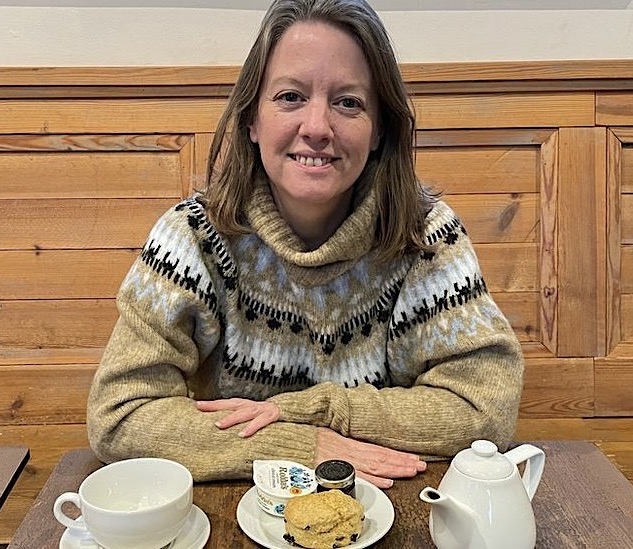 WHY THERE'LL
ALWAYS
WHY THERE'LL
ALWAYS
BE AN ENGLAND
A British woman named Sarah Merker (left), 49, was so passionate about scones and U.K. heritage sites, that she spent 10 years on a personal mission to visit 244 sites recognized by the National Trust and to sample a scone at every location.
❖❖❖
Any of John Mariani's books below may be ordered from amazon.com.
 The Hound in Heaven
(21st Century Lion Books) is a novella, and
for anyone who loves dogs, Christmas, romance,
inspiration, even the supernatural, I hope you'll find
this to be a treasured favorite. The story
concerns how, after a New England teacher, his wife and
their two daughters adopt a stray puppy found in their
barn in northern Maine, their lives seem full of promise.
But when tragedy strikes, their wonderful dog Lazarus and
the spirit of Christmas are the only things that may bring
his master back from the edge of despair.
The Hound in Heaven
(21st Century Lion Books) is a novella, and
for anyone who loves dogs, Christmas, romance,
inspiration, even the supernatural, I hope you'll find
this to be a treasured favorite. The story
concerns how, after a New England teacher, his wife and
their two daughters adopt a stray puppy found in their
barn in northern Maine, their lives seem full of promise.
But when tragedy strikes, their wonderful dog Lazarus and
the spirit of Christmas are the only things that may bring
his master back from the edge of despair. WATCH THE VIDEO!
“What a huge surprise turn this story took! I was completely stunned! I truly enjoyed this book and its message.” – Actress Ali MacGraw
“He had me at Page One. The amount of heart, human insight, soul searching, and deft literary strength that John Mariani pours into this airtight novella is vertigo-inducing. Perhaps ‘wow’ would be the best comment.” – James Dalessandro, author of Bohemian Heart and 1906.
“John Mariani’s Hound in Heaven starts with a well-painted portrayal of an American family, along with the requisite dog. A surprise event flips the action of the novel and captures us for a voyage leading to a hopeful and heart-warming message. A page turning, one sitting read, it’s the perfect antidote for the winter and promotion of holiday celebration.” – Ann Pearlman, author of The Christmas Cookie Club and A Gift for my Sister.
“John Mariani’s concise, achingly beautiful novella pulls a literary rabbit out of a hat – a mash-up of the cosmic and the intimate, the tragic and the heart-warming – a Christmas tale for all ages, and all faiths. Read it to your children, read it to yourself… but read it. Early and often. Highly recommended.” – Jay Bonansinga, New York Times bestselling author of Pinkerton’s War, The Sinking of The Eastland, and The Walking Dead: The Road To Woodbury.
“Amazing things happen when you open your heart to an animal. The Hound in Heaven delivers a powerful story of healing that is forged in the spiritual relationship between a man and his best friend. The book brings a message of hope that can enrich our images of family, love, and loss.” – Dr. Barbara Royal, author of The Royal Treatment.
 |
The Encyclopedia of American Food and Drink by John F. Mariani (Bloomsbury USA, $35) Modesty forbids me to praise my own new book, but let me proudly say that it is an extensive revision of the 4th edition that appeared more than a decade ago, before locavores, molecular cuisine, modernist cuisine, the Food Network and so much more, now included. Word origins have been completely updated, as have per capita consumption and production stats. Most important, for the first time since publication in the 1980s, the book includes more than 100 biographies of Americans who have changed the way we cook, eat and drink -- from Fannie Farmer and Julia Child to Robert Mondavi and Thomas Keller. "This book is amazing! It has entries for everything from `abalone' to `zwieback,' plus more than 500 recipes for classic American dishes and drinks."--Devra First, The Boston Globe. "Much needed in any kitchen library."--Bon Appetit. |
"Eating Italian will never be the same after reading John Mariani's entertaining and savory gastronomical history of the cuisine of Italy and how it won over appetites worldwide. . . . This book is such a tasteful narrative that it will literally make you hungry for Italian food and arouse your appetite for gastronomical history."--Don Oldenburg, USA Today. "Italian
restaurants--some good, some glitzy--far
outnumber their French rivals. Many of
these establishments are zestfully described
in How Italian Food Conquered the World, an
entertaining and fact-filled chronicle by
food-and-wine correspondent John F.
Mariani."--Aram Bakshian Jr., Wall Street
Journal.
"Equal parts
history, sociology, gastronomy, and just
plain fun, How Italian Food Conquered the
World tells the captivating and delicious
story of the (let's face it) everybody's
favorite cuisine with clarity, verve and
more than one surprise."--Colman Andrews,
editorial director of The Daily
Meal.com. "A fantastic and fascinating
read, covering everything from the influence
of Venice's spice trade to the impact of
Italian immigrants in America and the
evolution of alta cucina. This book will
serve as a terrific resource to anyone
interested in the real story of Italian
food."--Mary Ann Esposito, host of PBS-TV's
Ciao
Italia. "John Mariani has written the
definitive history of how Italians won their
way into our hearts, minds, and
stomachs. It's a story of pleasure over
pomp and taste over technique."--Danny Meyer,
owner of NYC restaurants Union Square
Cafe, The Modern, and Maialino.
|
 |
 |
 |
 |
 |
 |
MARIANI'S VIRTUAL GOURMET
NEWSLETTER is published weekly. Publisher: John Mariani. Editor: Walter Bagley. Contributing Writers: Christopher
Mariani, Misha Mariani, John A. Curtas, Gerry Dawes, Geoff Kalish.
Contributing
Photographer: Galina Dargery. Technical
Advisor: Gerry
McLoughlin.
If you wish to subscribe to this
newsletter, please click here: http://www.johnmariani.com/subscribe/index.html
© copyright John Mariani 2023
